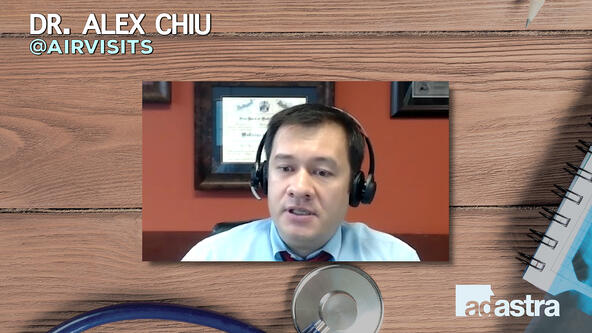Healthcare and Language Access Series: Dr. Chiu Interview – Part 1
Healthcare and Language Access Series

While the world continues to experience the COVID, technology has been playing a critical role in facilitating “normal life” activities as we are quarantined/”socially distanced” from one another to help curb the spread of the virus.
Due to these circumstances, more and more people have adopted technology and become more adept using technology platforms to help us socialize, work, learn, and obtain medical and other necessary services.
We talked with Alexander Chiu, MD, MBA, an emergency medical doctor who is the CEO of Air Visits, Inc., to find out how telemedicine is positioned to meet the challenges of this current moment and beyond.
Dr. Alex Chiu, CEO of Air Visits
Anywhere, Anytime Access to Medical Professionals
For Dr. Chiu, his aim—well before the pandemic—has been to improve patient access to medical care by providing a virtual platform accessible by anyone and from anywhere. Providing billable telemedicine to all people regardless of location centers on giving patients from all backgrounds convenient access to improved healthcare. The very act of making it easier to connect with medical professionals so that they can address identified gaps in traditional medical care improves patient care and outcomes. Dr. Chiu’s team’s focus is on overlooked risk factors that lead to the top 10 causes of death in the U.S. (e.g., heart disease, stroke, cancer).
While telemedicine platforms have been evolving since before COVID-19 emerged, today’s coronavirus pandemic has caused many physicians to further adopt technology platforms so that they can continue to serve their patients and stay in business at a time when in-person visits are deemed unsafe.
Telemedicine is being used across a wide range of medical services, from routine check-ups, diagnoses, prescriptions, and testing to medical emergencies and COVID-19 evaluations and monitoring.
“What we are finding is that a lot of care we offer does not need to be in person,” Chiu said. “[Many services] don’t need hospital walls to be able to deliver, and you can really achieve a lot of the same outcomes,” he said.
Telehealth Growing Pains
The learning curve for using telemedicine platforms is not steep at this point, as many patients and doctors themselves have become accustomed to using video conferencing platforms like FaceTime or Zoom for social and work purposes.
But, like any burgeoning change in a well-established system, there are growing pains. As the telehealth medium is increasingly used to address our needs, medical providers must adopt some very specific protocols to match the in-person services they are accustomed to providing. And these do not automatically appear with telehealth video conferencing platforms.
Dr. Chiu explained that one of the largest pitfalls with primary care physicians who are just starting to use telemedicine is that they often don’t know how to chart and bill for remote appointments and are less prepared for emergencies.
Thus, the right type of infrastructure and methods for such areas as billing and remote activation of 911 services, as well as language access services are important to prepare for serving the total needs of the population within the U.S. medical system.
Connecting with a patient who is calling from literally anywhere requires that physicians’ practices can serve these patients—or find them help if their mobile device/internet fails or there is a time-sensitive emergency.
Communication & Language Access is Key
Dr. Chiu says that physicians should make sure to eliminate barriers to care, such as language barriers, through preparation. Communication is key to giving patients complete care, and it is imperative that patients fully comprehend what physicians are telling them at each step in care—and vice versa.
To this end, to ensure remote video medical consultations are effective with Limited English Proficient (LEP) and Deaf and Hard of Hearing individuals, Dr. Chiu believes that any telehealth practice should integrate both in-house bilingual professionals and an external on-demand service that enables on-demand connection to language interpreters.
Often, there is simply not enough time to figure out how to facilitate communication fast enough to help someone who is in the middle of an emergency. As telemedicine continues to evolve, its success may well depend on providers’ ability to readily handle any situation to serve the unique needs of patients from diverse backgrounds and with an array of medical issues.
Below is Part 1 of the interview with Dr. Chiu, who discusses why it’s important for providers to prepare for all contingencies while performing telehealth.
Check out Part 1 of our full length interview with Dr. Alex Chiu below!




